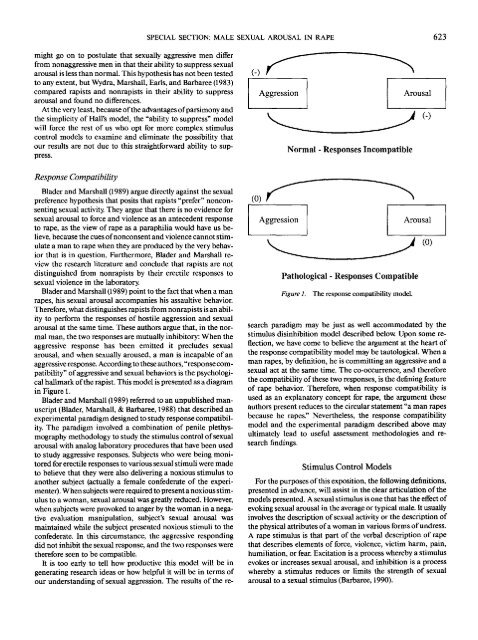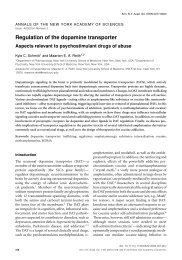The Role of Male Sexual Arousal in Rape: Six Models
The Role of Male Sexual Arousal in Rape: Six Models
The Role of Male Sexual Arousal in Rape: Six Models
You also want an ePaper? Increase the reach of your titles
YUMPU automatically turns print PDFs into web optimized ePapers that Google loves.
might go on to postulate that sexually aggressive men differ<br />
from nonaggressive men <strong>in</strong> that their ability to suppress sexual<br />
arousal is less than normal. This hypothesis has not been tested<br />
to any extent, but Wydra, Marshall, Earls, and Barbaree (1983)<br />
compared rapists and nonrapists <strong>in</strong> their ability to suppress<br />
arousal and found no differences.<br />
At the very least, because <strong>of</strong> the advantages <strong>of</strong> parsimony and<br />
the simplicity <strong>of</strong> Hall's model, the "ability to suppress" model<br />
will force the rest <strong>of</strong> us who opt for more complex stimulus<br />
control models to exam<strong>in</strong>e and elim<strong>in</strong>ate the possibility that<br />
our results are not due to this straightforward ability to sup-<br />
press.<br />
Response Compatibifity<br />
Blader and Marshall (1989) argue directly aga<strong>in</strong>st the sexual<br />
preference hypothesis that posits that rapists "prefer" noncon-<br />
sent<strong>in</strong>g sexual activity. <strong>The</strong>y argue that there is no evidence for<br />
sexual arousal to force and violence as an antecedent response<br />
to rape, as the view <strong>of</strong> rape as a paraphilia would have us be-<br />
lieve, because the cues <strong>of</strong>nonconsent and violence cannot stim-<br />
ulate a man to rape when they are produced by the very behav-<br />
ior that is <strong>in</strong> question. Furthermore, Blader and Marshall re-<br />
view the research literature and conclude that rapists are not<br />
dist<strong>in</strong>guished from nonrapists by their erectile responses to<br />
sexual violence <strong>in</strong> the laboratory.<br />
Blader and Marshall (1989) po<strong>in</strong>t to the fact that when a man<br />
rapes, his sexual arousal accompanies his assaultive behavior.<br />
<strong>The</strong>refore, what dist<strong>in</strong>guishes rapists from nonrapists is an abil-<br />
ity to perform the responses <strong>of</strong> hostile aggression and sexual<br />
arousal at the same time. <strong>The</strong>se authors argue that, <strong>in</strong> the nor-<br />
mal man, the two responses are mutually <strong>in</strong>hibitory: When the<br />
aggressive response has been emitted it precludes sexual<br />
arousal, and when sexually aroused, a man is <strong>in</strong>capable <strong>of</strong> an<br />
aggressive response. Accord<strong>in</strong>g to these authors, "response com-<br />
patibility" <strong>of</strong> aggressive and sexual behaviors is the psychologi-<br />
cal hallmark <strong>of</strong> the rapist. This model is presented as a diagram<br />
<strong>in</strong> Figure 1.<br />
Blader and Marshall (1989) referred to an unpublished man-<br />
uscript (Blader, Marshall, & Barbaree, 1988) that described an<br />
experimental paradigm designed to study response compatibil-<br />
ity. <strong>The</strong> paradigm <strong>in</strong>volved a comb<strong>in</strong>ation <strong>of</strong> penile plethys-<br />
mography methodology to study the stimulus control <strong>of</strong> sexual<br />
arousal with analog laboratory procedures that have been used<br />
to study aggressive responses. Subjects who were be<strong>in</strong>g moni-<br />
tored for erectile responses to various sexual stimuli were made<br />
to believe that they were also deliver<strong>in</strong>g a noxious stimulus to<br />
another subject (actually a female confederate <strong>of</strong> the experi-<br />
menter). When subjects were required to present a noxious stim-<br />
ulus to a woman, sexual arousal was greatly reduced. However,<br />
when subjects were provoked to anger by the woman <strong>in</strong> a nega-<br />
tive evaluation manipulation, subject's sexual arousal was<br />
ma<strong>in</strong>ta<strong>in</strong>ed while the subject presented noxious stimuli to the<br />
confederate. In this circumstance, the aggressive respond<strong>in</strong>g<br />
did not <strong>in</strong>hibit the sexual response, and the two responses were<br />
therefore seen to be compatible.<br />
It is too early to tell how productive this model will be <strong>in</strong><br />
generat<strong>in</strong>g research ideas or how helpful it will be <strong>in</strong> terms <strong>of</strong><br />
our understand<strong>in</strong>g <strong>of</strong> sexual aggression. <strong>The</strong> results <strong>of</strong> the re-<br />
SPECIAL SECTION: MALE SEXUAL AROUSAL IN RAPE 623<br />
S<br />
Aggression I <strong>Arousal</strong><br />
j (')<br />
S<br />
Normal - Responses Incompatible<br />
Aggression <strong>Arousal</strong><br />
j (0)<br />
Pathological - Responses Compatible<br />
Figure 1. <strong>The</strong> response compatibility model.<br />
search paradigm may be just as well accommodated by the<br />
stimulus dis<strong>in</strong>hibition model described below. Upon some re-<br />
flection, we have come to believe the argument at the heart <strong>of</strong><br />
the response compatibility model may be tautological. When a<br />
man rapes, by def<strong>in</strong>ition, he is committ<strong>in</strong>g an aggressive and a<br />
sexual act at the same time. <strong>The</strong> co-occurrence, and therefore<br />
the compatibility <strong>of</strong> these two responses, is the def<strong>in</strong><strong>in</strong>g feature<br />
<strong>of</strong> rape behavior. <strong>The</strong>refore, when response compatibility is<br />
used as an explanatory concept for rape, the argument these<br />
authors present reduces to the circular statement "a man rapes<br />
because he rapes:' Nevertheless, the response compatibility<br />
model and the experimental paradigm described above may<br />
ultimately lead to useful assessment methodologies and re-<br />
search f<strong>in</strong>d<strong>in</strong>gs.<br />
Stimulus Control <strong>Models</strong><br />
For the purposes <strong>of</strong> this exposition, the follow<strong>in</strong>g def<strong>in</strong>itions,<br />
presented <strong>in</strong> advance, will assist <strong>in</strong> the clear articulation <strong>of</strong> the<br />
models presented. A sexual stimulus is one that has the effect <strong>of</strong><br />
evok<strong>in</strong>g sexual arousal <strong>in</strong> the average or typical male. It usually<br />
<strong>in</strong>volves the description <strong>of</strong> sexual activity or the description <strong>of</strong><br />
the physical attributes <strong>of</strong> a woman <strong>in</strong> various forms <strong>of</strong> undress.<br />
A rape stimulus is that part <strong>of</strong> the verbal description <strong>of</strong> rape<br />
that describes elements <strong>of</strong> force, violence, victim harm, pa<strong>in</strong>,<br />
humiliation, or fear. Excitation is a process whereby a stimulus<br />
evokes or <strong>in</strong>creases sexual arousal, and <strong>in</strong>hibition is a process<br />
whereby a stimulus reduces or limits the strength <strong>of</strong> sexual<br />
arousal to a sexual stimulus (Barbaree, 1990).










